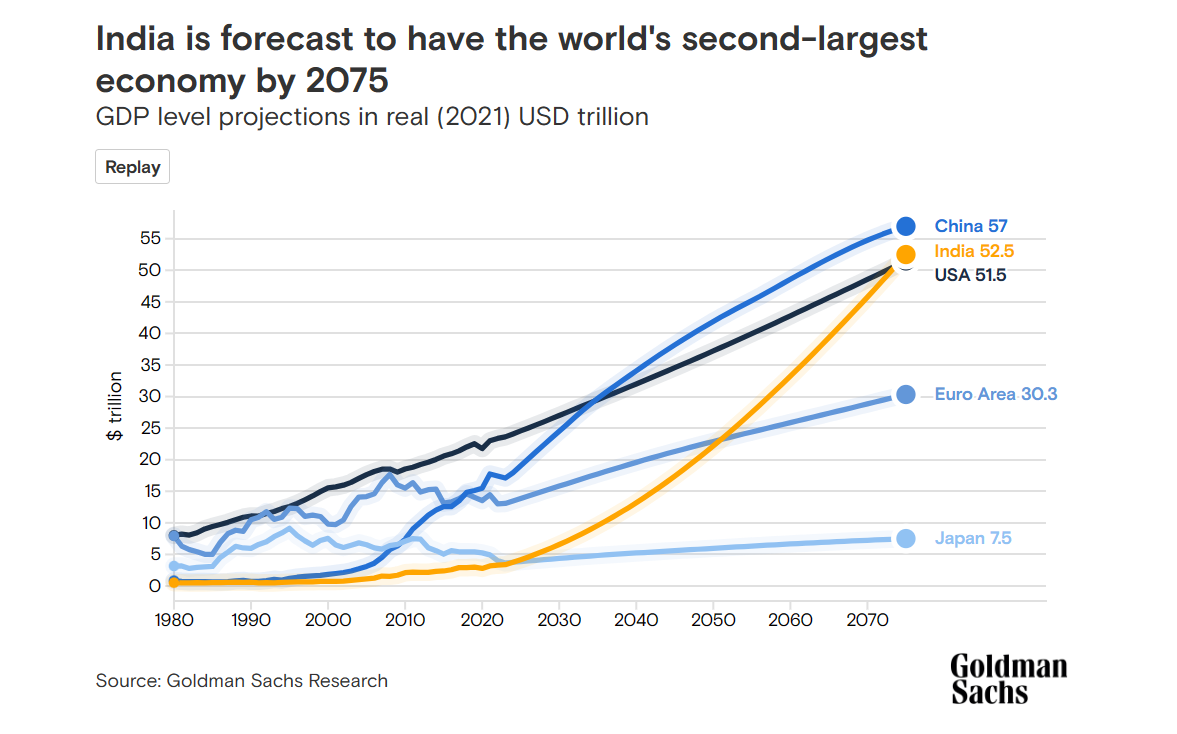Last Updated: July 11, 2023, 02:49 IST
United States of America (USA)
A man carries empty water bottles past a bronze replica of the Charging Bull of Wall Street, inside the premises of the Bombay Stock Exchange (BSE) in Mumbai, February 1, 2023. (Reuters)
India’s long-term forecast predicts it will surpass the US and become the world’s second-largest economy by 2075. There will be a number of key drivers
India is projected to become the world’s second-largest economy by the year 2075, surpassing the United States, according to a forecast by American investment bank Goldman Sachs. As the most populous nation on the planet with 1.4 billion people, India’s potential lies in boosting labor force participation and providing training and skills to its vast talent pool.
At the moment, India stands tall as the world’s fifth-largest economy. But the country’s favorable demographics, innovative advancements, and increasing worker productivity are expected to be key drivers of its economic growth, against the likes of Germany and Japan. Capital investment and favorable demographic, such as a low dependency ratio, are likely to contribute to India’s future expansion.
Santanu Sengupta, Goldman Sachs Research’s India economist, argued that India has made more progress in innovation and technology than some may realize.
“Yes, the country has demographics on its side, but that’s not going to be the only driver of GDP. Innovation and increasing worker productivity are going to be important for the world’s fifth-biggest economy. In technical terms, that means greater output for each unit of labor and capital in India’s economy,” he added.
According to Sengupta, capital investment is also going to be a significant driver of growth going forward.
However, challenges remain in harnessing the potential of the labor force and increasing the labor force participation rate. According to Goldman Sachs, the demographic transition in India is occurring gradually, and the country must leverage its large population to set up manufacturing capacity, drive infrastructure growth, and utilize its immense talent pool effectively.
India’s focus on creating infrastructure, both by the government and private sector, is seen as a crucial step in absorbing the large labor force and generating job opportunities. Risks to India’s economic growth include a stagnant labor force participation rate, particularly among women, and lower productivity growth, the report said.
To mitigate these risks, India must create more opportunities for women in the workforce and continue to invest in digitalization and technological advancements. India’s economy is primarily driven by domestic demand and consumption, with net exports historically acting as a drag on growth.
However, recent progress in services exports has helped cushion current account imbalances. Commodity prices also play a significant role in India’s macro economy, affecting inflation, fiscal deficit, and current-account deficit. As a large energy consumer, India’s current account imbalances are impacted by energy import bills.
While India is transitioning towards green energy, fossil fuels will continue to dominate the energy mix in the interim. The government has set ambitious targets for renewable energy generation, aiming for 50 percent of power capacity to come from non-fossil sources by 2030 and reaching net zero emissions by 2070.
This transition presents a significant investment opportunity, although the shift will take time, according to the report. Meanwhile, India is actively promoting electric vehicles, green hydrogen, and renewable energy to accelerate its energy transition.
This latest report comes as S&P Global and Morgan Stanley have projected India to become the world’s third-largest economy by 2030. The country’s first-quarter GDP exceeded expectations, expanding by 6.1 percent year-on-year, surpassing earlier projected growth of 5 percent.
(With agency inputs)

